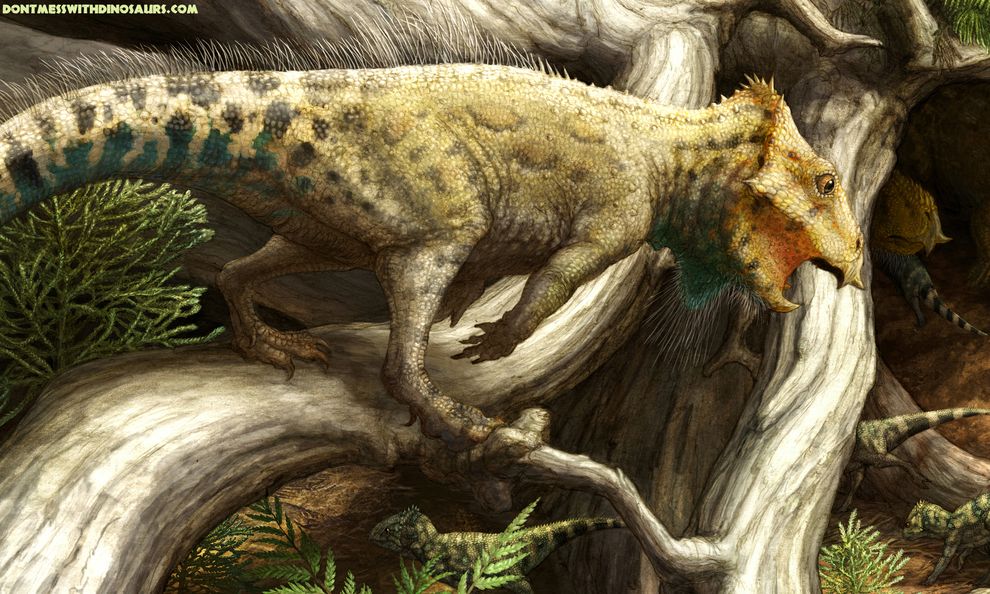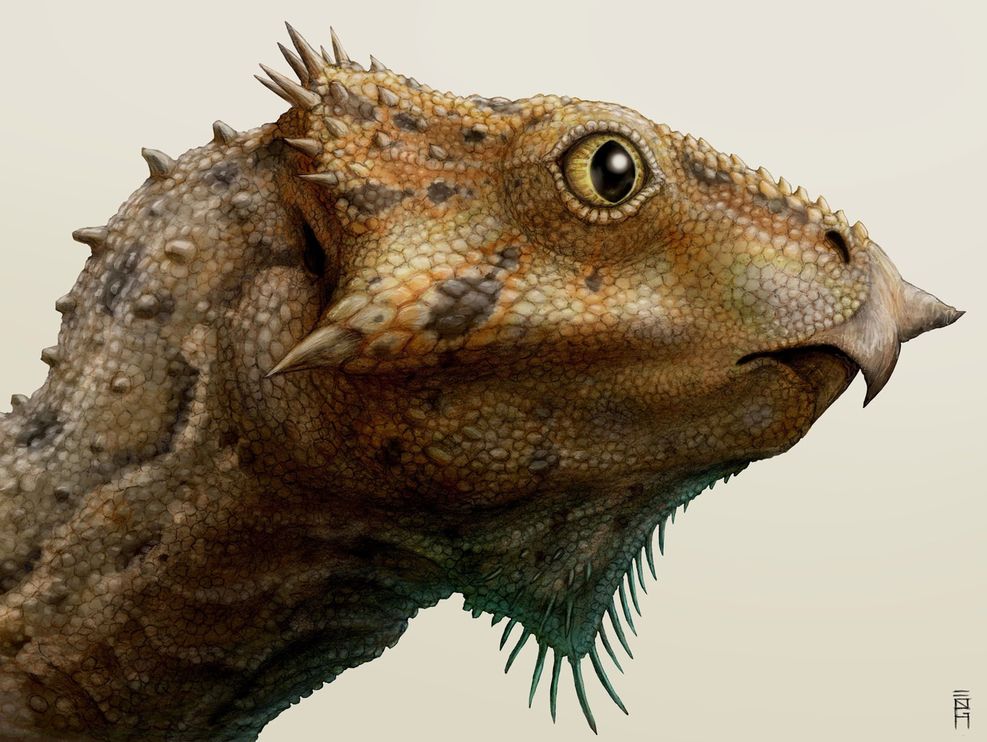fossilshk
(Lung)
管理員
  








UID 1
精華
23
積分 4751
帖子 2813
閱讀權限 200
註冊 2006-7-14
來自 中國/香港
狀態 離線
|
[廣告]:
Bunny-Size Dinosaur Was First of Its Kind in America
最早角龍類化石於北美發現

The little dinosaur Aquilops americanus (illustrated above) is the oldest known Triceratops relative found in North America.
Illustration by Brian Engh, courtesy of Raymond M. Alf Museum of Paleontology
A tiny horned skull discovered 17 years ago has now been named Aquilops americanus, and marks the earliest arrival of horned dinosaurs in North America.
The fossil skull is the oldest definitive evidence of a ceratopsian, the group of horned dinosaurs that includes Triceratops, on the continent. Paleontologists describe the dinosaur Wednesday in the journal PLOS ONE.
Named Aquilops for its "eagle-faced" appearance, the dinosaur was quite small. Based on comparisons with similar ceratopsians from Asia, paleontologist Andrew Farke expects that Aquilops was no more than two feet long (0.6 meter) and weighed about three and a half pounds (1.6 kilograms)—"about as much as a large bunny rabbit."
While the skull bones indicate that Aquilops was the dinosaur equivalent of an adolescent, Farke notes, the adult animal probably wasn't much bigger.
The paleontologists who found the little skull didn't know what they had found at first. In 1997, during a National Geographic Society-funded expedition to Montana led by Richard Cifelli of the Sam Noble Oklahoma Museum of Natural History, paleontologist Scott Madsen, currently at the Utah Geological Survey, found a rock dating to 109 million to 104 million years old—with teeth sticking out of it.
At first, the fossil looked like it might belong to a previously named dinosaur called Zephyrosaurus. But after freeing the skull from its encasing rock, Madsen realized it was a ceratopsian—incredibly rare for a North American fossil that old.

The only known fossil skull of Aquilops puts the dinosaur's small size in perspective; it was about the size of a rabbit.
Photograph by Andrew A. Farke
Fossils of later ceratopsians—such as Triceratops—are abundant in North America, but few from the early Cretaceous have been found. "There are other pieces of ceratopsians known from the Lower Cretaceous [of North America], but they're all things like isolated teeth or part of a tail from Idaho," says Farke, a paleontologist at California's Raymond M. Alf Museum who described the new dinosaur with Cifelli and colleagues.
While new discoveries are always being made, Farke says, finding more of Aquilops will take a lot of luck. Paleontologists have turned up multiple individuals of other dinosaurs, such as Tenontosaurus and Deinonychus, from the same rock unit, called the Cloverly Formation.
But Aquilops is the sole ceratopsian ever found in the formation, which has been searched regularly by paleontologists.
Unless paleontologists have just been missing their bones, Farke says, this hints that "this animal is a fairly marginal player at the fringes of the ecosystem."
Placing an Oddball
Still, even with a single skull, paleontologists can start to investigate how Aquilops lived. The dinosaur's beak is a clue. "The shape is unlike any other one in how strongly hooked it is," Farke says, which may be a clue that Aquilops was a choosy feeder that browsed on a relatively limited menu of Cretaceous vegetation.
In all, the little dinosaur is quite different from celebrity ceratopsians such as Triceratops and Styracosaurus. Those dinosaurs were separated from this one not only by about 50 million years, says Cleveland Museum of Natural History paleontologist Michael Ryan, but also in size and shape.
"Imagine a Chihuahua beside a Great Dane," Ryan says, adding that Aquilops lacked a frill (like the wide plate over the neck of Triceratops) and the long brow horns of later ceratopsians.

Like other horned dinosaurs, Aquilops americanus sported a curved beak and small horns, but it lacked the frill and long brow horns of its cousin Triceratops.
Illustration by Brian Engh
Farke and colleagues found that Aquilops belonged to a "side branch" of the ceratopsian family tree, populated with unusual little horned dinosaurs that proliferated during the early Cretaceous. In fact, the closest relatives of Aquilops lived on another continent, and that helps show how dinosaurs moved around the world.
Even though Aquilops was found in North America, it most closely resembles ceratopsians from Asia. This and other finds suggest there were at least three dispersals of horned dinosaurs from Asia to North America over about 60 million years, Ryan says.
Aquilops helps establish part of that picture, Ryan says, "and now that it's been officially described, we'll be able to more accurately talk about early horned dinosaur evolutionary history in North America."
http://news.nationalgeographic.c ... eontology-science/#
| 
 |
|



